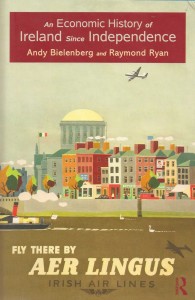An economic history of Ireland since independence
Published in Book Reviews, Featured-Book-Review, Issue 6 (November/December 2014), Reviews, Volume 22ANDY BIELENBERG and RAYMOND RYAN
Routledge
£85
ISBN 9780415566940
This is a very comprehensive and hugely satisfying survey of its subject-matter. It begins with British prime minister Lloyd George’s last-minute offer of full fiscal autonomy during the Treaty negotiations that led to independence in 1922 and takes us right up to the bank guarantee of 2008 that would lead to the loss of Irish fiscal sovereignty two years later. It has been a rocky road, as the title of a previous short economic history of Ireland puts it.
The study proceeds in three parts. Part 1 provides a chronological account of the Irish experience from 1922 to the present, broken down into pre-EU and post-EU membership phases. Part 2 analyses in turn developments within agriculture and natural resources, industry and services. The subtitle of the services section—‘from good haircuts to bad bankers’—reminds us of the heterogeneity of the sector. The Irish services sector is particularly complex in that it includes huge exports of international financial and information technology services by foreign multinational corporations (MNCs), as well as huge debit-side items—royalties and licence fees—that are associated with the heavy presence of foreign manufacturing MNCs. The importance of foreign MNCs to the modern economy and the possibilities open to them of shifting profits across jurisdictions hamper the interpretation of Irish output data. The book reviews all of these issues. Part 3 slices the pie along three different dimensions, focusing in turn on international trade; investment and credit; and demography and the labour force.
The chronological account in Part 1 is thoroughly enjoyable to read, while the mat-erial in Parts 2 and 3 is necessarily more dense, containing a treasure trove of useful reference material. The judgements offered throughout the book—right up to the most recent events—seem fair and balanced. And the authors appear equally at home over all the phases, from the targeted protection of the 1920s to the full-blown protection of the 1930s and beyond, from the liberalisation of the economy to the debt crisis that followed the oil shocks, and from the long Celtic Tiger boom that finally brought convergence on Western European living standards to the bursting of the property and financial bubble that will leave the economy mired in debt for years to come.
The authors at the outset offer a number of competing models as prisms through which these developments might be understood. One is the ‘delayed convergence hypothesis’—the notion that a long series of policy errors (delayed trade liberalisation, delayed educational expansion, misguided fiscal policies) inhibited convergence for most of the period up to the late 1980s, with rapid catch-up occurring when these errors were ultimately rectified. An alternative perspective is offered by the ‘regional economy model’, in which ease of access to outside labour markets (predominantly the UK since the early 1930s) places a floor under Irish real wages and thereby inhibits industrialisation. An implication is that some unconventional policy mix, such as our low corporation tax regime, is or was necessary to kick-start sustainable industrial development.
Towards the end of the book the authors focus primarily on a third perspective—that of the ‘micro-state’. Very small states have some advantages: they can respond more rapidly, more flexibly and more wholeheartedly to external changes than larger states can, and of course attracting a single major MNC generates stronger ripples than it would in a larger pond. But micro-economies display particular vulnerabilities as well. As they point out, ‘small and cohesive social elites are especially vulnerable to corruption and regulatory capture’. To this may be added the problem of ‘groupthink’ alluded to by one of the independent reports into the causes of the Irish banking crisis. Similar criticisms have been made of how Iceland functioned in the lead-up to its own catastrophic crisis.
The recent Scottish independence referendum probably caused many Irish people to reflect on what exactly have been the economic achievements of Irish independence. Decades of protectionism did not succeed in reorienting us away from dependence on the UK economy. Our corporation tax policy, which is part and parcel of Ireland’s EU story (it facilitated trade liberalisation by opening up a new source of jobs to replace those that would be lost as protectionist-era industry faded away), helped to disentangle us from the UK and was one of the driving forces behind the ‘good boom’ of the 1990s (to be distinguished from the bubble economy of the 2000s). The relatively high-tech structure of the Irish economy has focused the attention of policy-makers on the importance of education: the educational attainment levels of Ireland’s under-30s is among the highest in the world. And there is the danger that the depth of the economic downturn may blind us to some of our other achievements. Maternal and infant mortality rates in Ireland are well below those in the UK and the US, for example.
The Irish record remains a patchwork of achievement and failure. On some issues—such as the embracing of international integration—we have managed to embed the lessons learnt from previous policy errors. In many other areas, however, we remain vulnerable to the particular peculiarities of the ‘micro-state’. Did Garret FitzGerald have such states particularly in mind when he wrote that ‘democratic governments tend to be subject to such strong pressure from vested interests that many of their decisions operate against the interests of society as a whole’? This can only really be addressed through constant vigilance.

















